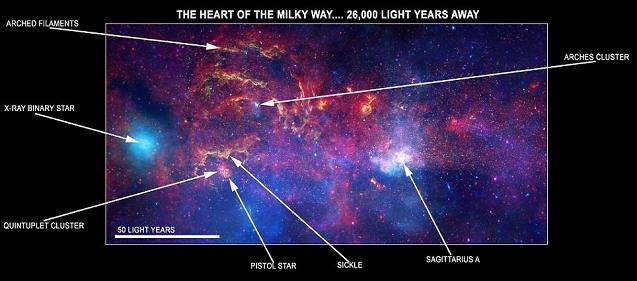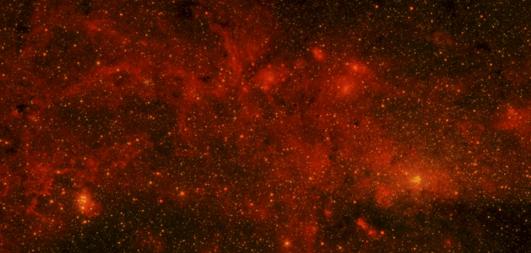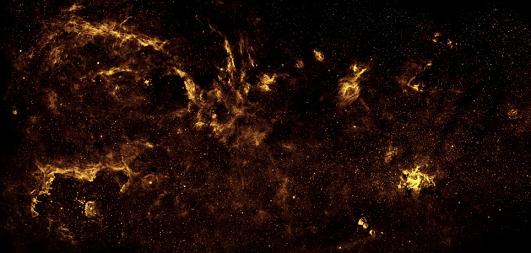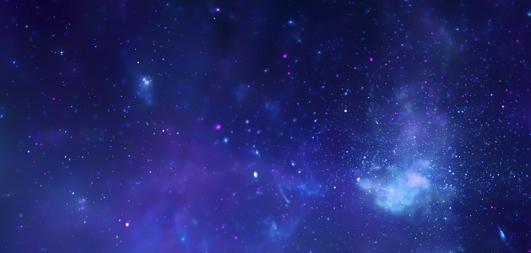The Milky Way as you've never seen it before: The colourful centre of our galaxy in all its glory
Claire Bates
[Unprecedented: A beautiful composite image of the Milky Way centre using observations from the Hubble Space Telescope, the Spitzer Space Telescope, and the Chandra X-ray Observatory]
Colourful, swirling clouds of cosmic dust interspersed with glowing star clusters are revealed in this extraordinary image of the Milky Way.
The dazzling image combining reds, yellows, blues and purples, was created by layering stunningly detailed pictures from the Hubble Space Telescope, the Spitzer Space Telescope and Chandra X-ray Observatory on top of each other.
The Milky Way is at the centre of our own galaxy and this image shows its core. The image was created to celebrate the 400th anniversary of Galileo Galilei's first demonstration of his telescope.
ARCHED FILAMENTS: These are located 85 light years from the centre of the Milky Way, the Sagittarius A area. The 'filaments' are roughly ten light years long and one wide. One light year is nearly 6 million million miles, the distance light travels in a year. ARCHES CLUSTER: The densest known star cluster within the Milky Way containing about 1,000 'young' stars X-RAY BINARY STAR: The glow is created by two stars, hence binary, orbiting a centre of mass QUINTUPLET CLUSTER: It is a collection of stars which is 4million years old and contains 10,000 times the mass of our Sun PISTOL STAR: This is the biggest type of star known in the universe and is called a 'blue hyper giant'. Like our Sun it has solar winds but these are 10billion times more powerful. Astronomers believe the Pistol Star will soon undergo a massive stellar explosion known as a supernova. Our solar system was probably created by such an event. SICKLE: The Sickle is made up of dense dust clouds which are given their shape by radiation and solar winds from 'young' stars SAGITTARIUS A: This is the centre of the Milky Way. Astronomers believe that it contains a massive black hole, a space with a gravitational field so intense that no matter or radiation can escape. Evidence for this includes mysterious radio waves emitted from this area. |
[Observations from Spitzer (top) Hubble (centre) using infra-red and Chandra (bottom) using X-rays created the most detailed picture of our galactic centre.]
[The Earth is on the Orion arm of the Milky Way. The telescopes peered towards the centre of our galaxy:]

The three space observatories peered into the central region of the Milky Way, which is 26,000 light years from Earth. One light year is nearly 6 million million miles, the distance light travels in a year.
The Milky Way is a barred spiral galaxy, which is a galaxy with spiral arms and a central bar-shaped structure composed of stars. Our solar system sits half-way along the minor Orion arm on the inner rim. The arm or 'spur' is named due to its proximity to stars in the Orion constellation.
Scientists were able to see through the obscuring dust and into the intense activity near the galactic core using infrared light and X-rays.
They created an image 250 light years across with the width of the picture covering about the same angular width as the full Moon.
The image reflects the spirit of international cooperation in astronomical research as the Hubble Telescope is a collaboration between the European Space Agency and Nasa. Both Spitzer and Chandra are part of the American space agency's observatories programme.
Each telescope's contribution has been presented in a different colour. Yellow represents the near-infrared observations of Hubble, which is better known for its astonishing visible-light pictures.
These infrared observations outline the most active regions where stars are being born and reveal hundreds of thousands of stars.
The galactic centre is marked by the bright patch in the lower right. Along the left side are large arcs of warm gas that have been heated by clusters of bright massive stars. In addition, Hubble uncovered many more massive stars across the region.

[Portrait of Galileo Galilei - the father of modern
astronomy.]
Winds and radiation from these stars create the complex structures seen in the gas throughout the image.
This sweeping panorama is one of the sharpest infrared pictures ever made of the galactic center region.
Red represents the infrared observations of Spitzer. The radiation and winds from stars create glowing dust clouds that form complex structures from compact spheres to long, stringy filaments.
Blue and violet represent the X-ray observations of Chandra. X-rays are emitted by gas heated to millions of degrees by stellar explosions and outflows from the super-massive black hole in the galaxy's centre.
The bright blue blob on the left side is an emission from a double star system containing either a neutron star or a black hole. A supermassive black hole - some four million times more massive than the Sun - resides within the bright region in the lower right.
When these views are brought together, the composite image provides one of the most detailed views ever of our galaxy's mysterious core. The image was created to mark the work of the Italian astronomer and physicist Galileo (1564-1642). He applied the telescope to astronomy and observed craters on the moon, sunspots and the phases of Venus.
Dr Robert Massey from the Royal Astronomical Society said: 'This image reminds us how far astronomy has come as it was only 400 years ago that we looked up at the stars through telescopes.
'In fact we wouldn't have had a clue what was in the centre of our galaxy just a few decades ago and now it is crystal clear.'
Simply Beautiful!
¤ ¤ ¤ ¤ ¤
Source: http://www.dailymail.co.uk/sciencetech/article-1226815/The-Milky-Way-youve-seen-The-intense-centre-galaxy-glory.html
Via: http://awakentopeaceandlove.blogspot.com/2009/11/milky-way-as-youve-never-seen-it-before.html





























